LG G2 and MSM8974 Snapdragon 800 - Mini Review
by Brian Klug on September 7, 2013 1:11 AM EST- Posted in
- Smartphones
- LG
- Mobile
- LG G2
- Android 4.2
- MSM8974
- Snapdragon 800
CPU Performance
LG's G2 features a quad-core Snapdragon 800 SoC (MSM8974). For a quick refresher, Snapdragon 800 features four Krait 400 cores running at up to 2.3GHz courtesy of TSMC's 28nm HPM process. The 2.3GHz max clock speed comes at a surprisingly low voltage thanks to the low power HPM process. Gone are the days of 1.4V to hit near-2GHz frequencies it seems, instead 8974 will hit 2.3 GHz at around 1V. Krait 400 improves L2 access latencies over Krait 300 (which is at the heart of Snapdragon 600 and S4 Pro) and is optimized for higher frequency operation, but Krait 400 is otherwise architecturally similar to Krait 300. Make no mistake, MSM8974 is the new high-end, pushing Snapdragon 600 and S4 Pro parts further down into midrange category. There are other SoC level enhancements as well, including things like a new version of the Hexagon DSP and obviously Adreno 330 vs. Adreno 320 (which I'll get to later). We already ran through a performance preview of Snapdragon 800/MSM8974 using Qualcomm's 8974 Tablet Mobile Development Platform, but today we get to do the same with the G2.
LG was pretty eager to get us a G2 sample as early as possible, unfortunately that comes at the expense of software maturity. LG made it very clear to us that the International G2 sample (LG-D802) we received has nowhere near final software, and as a result may not deliver performance indicative of what we'll see when the device shows up later this month. This puts us in an interesting situation as we want to see how close shipping Snapdragon 800 devices come to the Snapdragon MDP/T we tested back in June. Software maturity aside, there's no skirting the fact that the G2 simply has a smaller chassis and perhaps lower thermal limits than the tablet MSM8974 MDP/T we tested previously.
The most interesting comparison points here will be to LG's Optimus G Pro which ships with a Snapdragon 600 (4 x Krait 300 running at 1.7GHz), the Exynos 5 Octa based Galaxy S 4 (SHVE300S) and to the MDP/T. As always, we'll start with a look at CPU performance.
The state of CPU performance testing under Android is unfortunately still quite broken. We're using a mix of browser based tests with Java & Native apps (AndEBench).
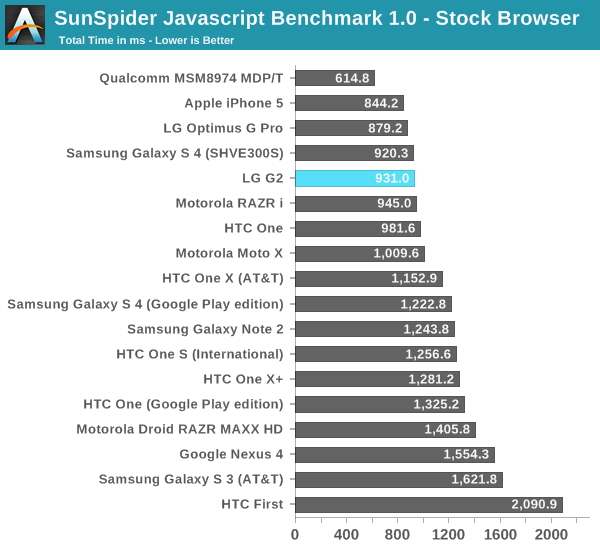
SunSpider has quickly become an exercise in browser optimization rather than platform performance. Qualcomm's browser optimizations are clearly good for showing off Snapdragon 800's potential, however the G2 doesn't appear to have the same optimizations in place (yet). Performance isn't bad, but it's merely on par with Snapdragon 600 and ARM's Cortex A15.
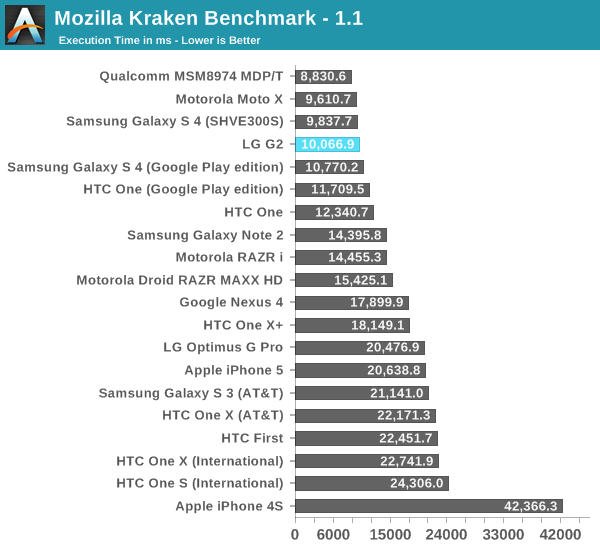
Kraken is an interesting test as it has (thus far) remained less of a browser optimization target. Kraken is also a physically larger and longer benchmark, which provides results that I tend to be a little happier with. The G2 once again falls short of Qualcomm's MDP/T, but given its early software I'm not too surprised. Performance is roughly on par with the Exynos 5 Octa, and slightly behind the very high clocked Snapdragon 600 in the nearly stock Moto X.

Octane is the first benchmark where we see the Snapdragon 800 flex its potential. Here the G2 not only ties the Snapdragon 800 MDP/T, but it also roughly equals the performance of the Cortex A15 based Exynos 5 Octa. Ultimately that's the comparison that Qualcomm will be most interested in winning. If Snapdragon 800 can deliver better performance (or at least perf per watt) than the Cortex A15, it'll be a definite win for Qualcomm.
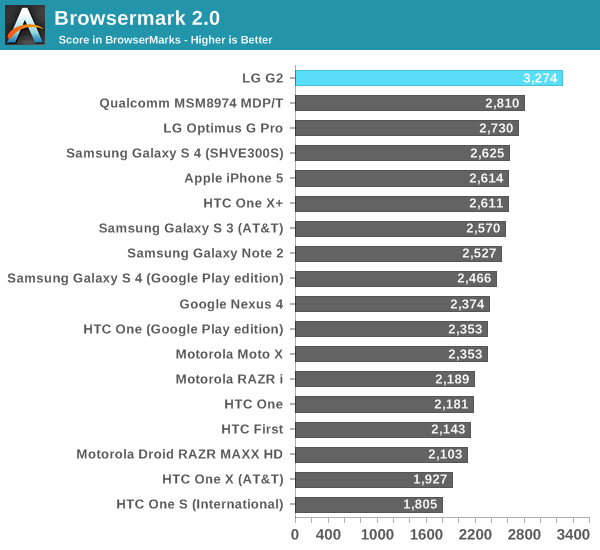
If Octane had the S800 in the proverbial passing lane, Browsermark 2.0 shows the G2 in the clear lead. Here LG was able to even outperform Qualcomm's own reference design by 16%. I suspect this has more to do with browser optimizations than anything else though, as the S600 based Optimus G Pro also does extremely well.
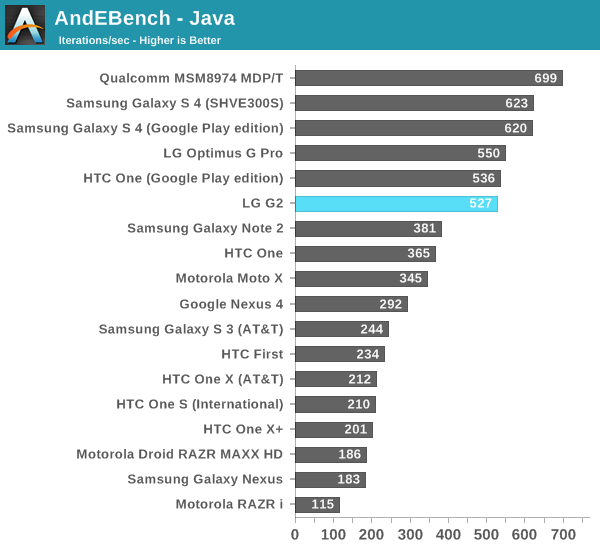
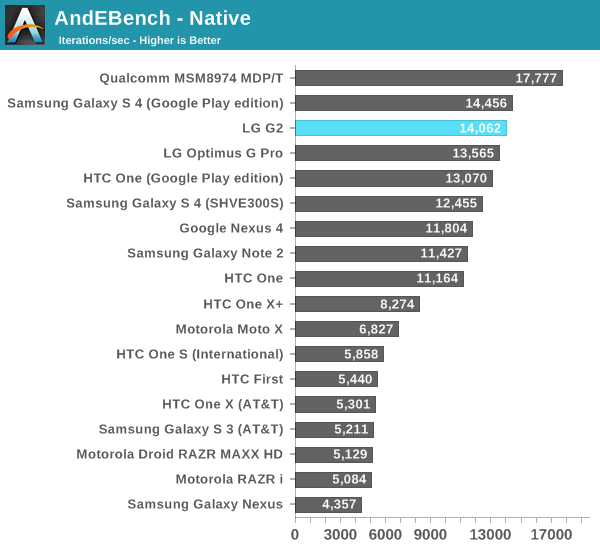
AndEBench provides us with very low level look at SoC performance. I'm not a huge fan of these types of tests, especially ones that aggregate a bunch of microbenchmarks and attempt to present a single performance number. AndEBench is unique (and useful) in that it presents performance in both native code and Dalvik interpreted states. The G2's native performance here is quite good, but it's actually equalled by the Galaxy S 4 GPe and not far ahead of the Optimus G Pro. I suspect we're once again seeing the limits of early software rather than a full understanding of Snapdragon 800's performance in a retail device. Dalvik performance is a bit worse. The relatively high ranking of the Google Play Edition devices points to software optimization being a culprit here.
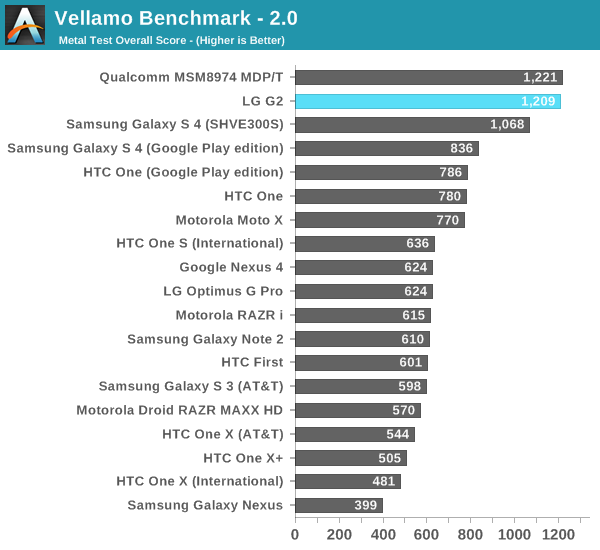

Both Vellamo tests put the G2 on par with Qualcomm's Snapdragon 800 MDP/T.








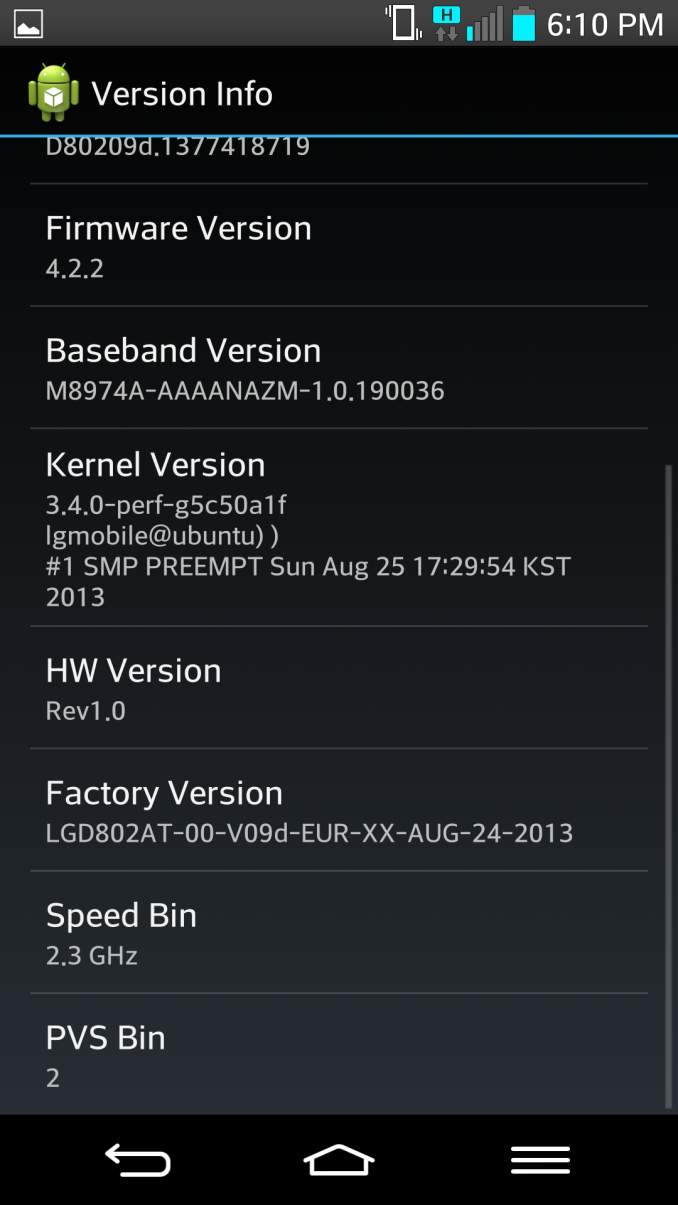
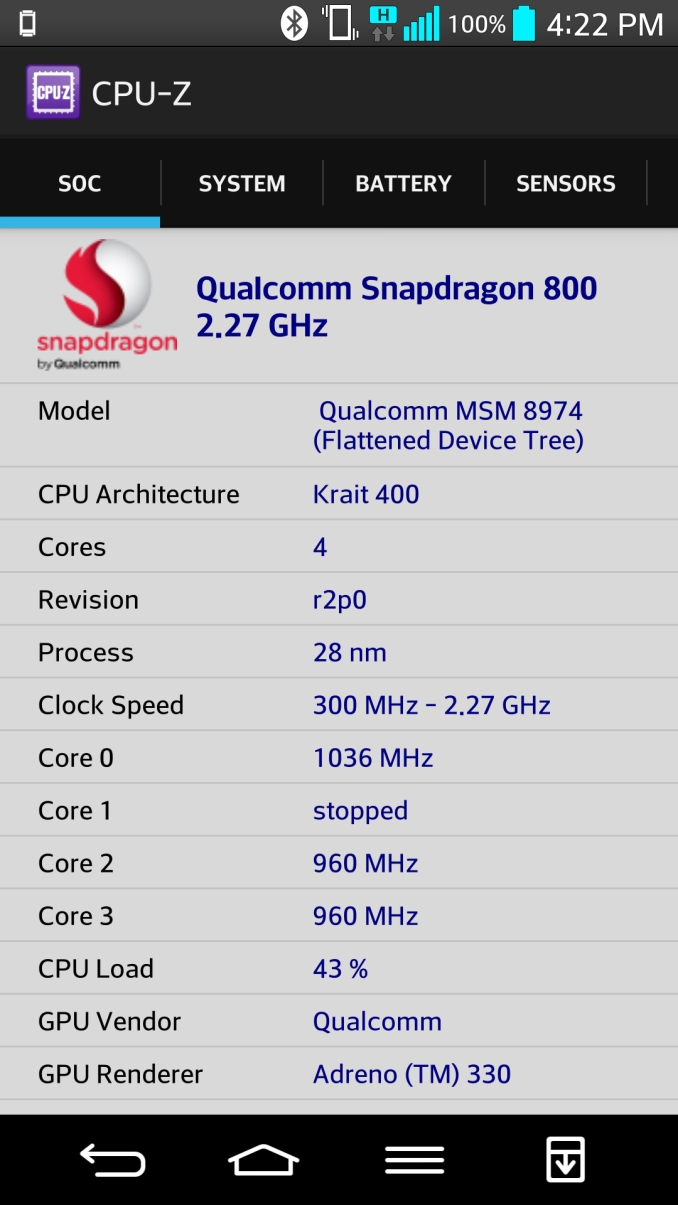








120 Comments
View All Comments
tuxRoller - Saturday, September 7, 2013 - link
You are making a point which, given our data, is impossible to prove/disprove.They are saying, I think, that they don't believe MOST people care about having a removable sdcard. Given that iphones sell so well, I'd think that there are very large groups for which this is true (roughly a third of smartphone owners worldwide). Samsung offers removable storage, but so have the other manufacturers (like sony) yet it hasn't/isn't helping them.
flyingpants1 - Saturday, September 7, 2013 - link
The people who are generally knowledgeable about phones are the ones recommending Samsung Galaxy S3/S4 to their friends. Partially because of the extra features like removable/customizable battery and storage. These features always get a mention in reviews also. You're a fool if you think they're not a factor in Samsung's success.Right now in my S4 I have the capability to add a 64gb microsd card purely for movies and TV shows and crap like that. That would cost me $50, whereas an additional device like an iPod touch would cost me a lot more. I'd rather just turn my phone into my iPod, but I just CANNOT do that if I have to constantly worry about my onboard space.
All flagship phones going forward should be 32gb+.
rocketbuddha - Monday, September 9, 2013 - link
Dude!a) How many HTC phones have you owned?
b) Do you know how many software updates HTC does for its "premium" phones in its life cycle?
c) Have you seen the quality of the software releases for 1-2 yr old phones? Battery life/random restarts etc....
Arbie - Monday, September 9, 2013 - link
I agree with BabelHuber. No micro/SD = no sale. Talk all you want about how "most of us are streaming from the cloud" or "internal memory is lots faster" - but that means nothing to me. I *DO* want to watch and listen to media and I *DO* want to move it on and off the device quickly. Like when I grab the thing for a trip. Micro/SD lets me do this and works GREAT. You stream; I'll snap.Micro/SD is worth $$ to me. Conversely, I'm not going to spend $$$$ on a device like this without it. As Babel says: why take the phone with less options? It simply does not make sense.
hughlle - Monday, September 9, 2013 - link
Yet people happily take the iphone with less options time and time again. apple market their harware properly, and the lack of options becomes irrelevant.The lack of an SD card will certainly cause a loss of sales from a certain market, but it is a minimal loss of sales in the grand scheme of things. Rather like imagining the loss of sales from people who won't buy this phone because it's not available in pink. It's a non-event.
As has been said, the majority of people care about total space, not removable storage. you can not put an accurate number on the ratio, but to try and argue it is otherwise is silly. The majority want to be able to take photos, record videos, dowload music and shows, not root around in their handbag or pocket or draw for the correct SD card that has their scrubs episodes on it. Average joe wants simplicity. they want to be able to press the screen and access their content. Not start swapping cards in and out.
Impulses - Saturday, September 7, 2013 - link
Yes, the power of branding is incredible. The words Samsung and Galaxy are pounded into the social consciousness to the point that they're now synonymous with Android (like Moto/VZW's Droid campaign early on). It's a very very strong effect.Impulses - Saturday, September 7, 2013 - link
I don't think sporting removable media and batteries is even amongst the top three reasons why Samsung outsells everyone... I think to imply so seems a bit near sighted. Samsung started dominating long before most manufacturers moved to sealed batteries etc, you can trace their upward track pretty closely to how much more they invested in branding with each successive generation (much to the carrier's chagrin, if it were up to them we'd still have five different Galaxy variations every year).Personally I could care less for removable media and batteries, but I do appreciate and applaud the fact that Samsung still offers that choice... I think it's one of the advantages of the Android ecosystem. I don't think the majority of the market cares about this tho.
Spunjji - Monday, September 9, 2013 - link
As someone who'd be moving from a Note 2 with 16GB internal and 64GB Micro SD, I think I'd actually appreciate the smaller unified space. It'd be a bit more of a pinch, but the fact is that after several re-formats and changes of software I'm getting sick to the back teeth of different builds treating my SD card differently (no exFAT support in CM10 is a real killer) and having to re-create links from my in-built storage to the external for apps like Google Play Music.The fact is that external removable storage is a pig to set up and maintain. It could work so much better than it does, but Google don't want to maintain it and I think the point where it's worth letting go has now arrived.
[-Stash-] - Tuesday, September 10, 2013 - link
No exFAT in CM10 is a pain, I'll agree, but since you root your phone anyway, just bung this on, it means you can even read/write to NTFS formatted storage (SD Cards, USB HDDs):https://play.google.com/store/apps/details?id=eu.c...
bill5 - Saturday, September 7, 2013 - link
This seemingly would be the phone to get if I needed one right now. Nice battery life.However my upgrade isnt for almost a year, like a lot of people I suspect, I upgraded right when SGS3 came out.
That means I wont be due for another upgrade til SGS5 hits, and I'm guessing it will trump this phone, naturally. Such is the life of everybody trying to fight samsung...